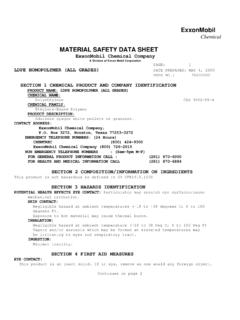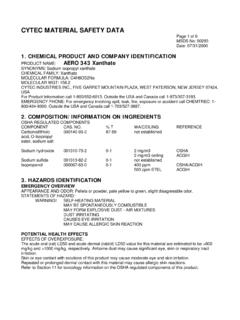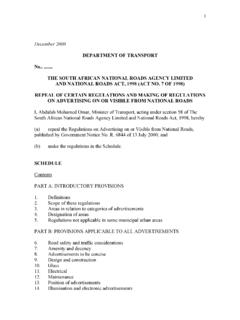Transcription of Multiple Chemical Sensitivities
1 MCS Task ForceMultipleChemicalSensitivitiesMCS TASKFORCEThe MCS Task Force of New Mexico is astatewide advocacy organization comprised ofchemically sensitive New Mexicans andsupporters. The organization is dedicated toincreasing awareness of MCS and educatingothers about the hazards of high and low levelchemical Chemical Sensitivities Task Force505-983-9208 , 505-466-3622NM Department of Health, Public Health Division505-827-2389NM Environment Department800-219-6157, 505-827-2855NM Governor's Committee on Concerns of theHandicapped877-696-1470 (in-state toll free), 505-827-6465 Web SitesChemical Injury Information Network406-547-2255 Ecology Action League404-248-1898 Referral and Resources410-362-6400 & Environment Resource Healthy Housing NM Department of Exposures, Low Levels and HighStakes, Ashford and Miller, of Progress, Alison Johnson, to the Twentieth Century, PeterRadetsky, Well in a Toxic World, Lynn Lawson, Chemical Sensitivity, A Survival Guide,Pam Gibson, for a Healthy House, Baker, Elliott,and Banta, Multiple Chemical Sensitivity, How ChemicalExposures May be Affecting Your Health, AlisonJohnson, Sick Schools, Doris Rapp, MD, Chemical SensitivitiesTask Force of New Box 23079, Santa Fe, NM 87502505-983-9208.
2 505-466-3622printed on recycled paper 11/00 MultipleChemicalSensitivitiesAlook at a growing problemIn collaboration withNew Mexico Department of HealthNew Mexico Environment DepartmentNew Mexico State Department ofEducationNew Mexico Governor's Committeeon Concerns of the HandicappedWHATISMCS? Multiple Chemical Sensitivities (MCS) is amedical condition characterized by debilitatingchemical Sensitivities . People who are chemicallysensitive are made sick by exposures tochemicals found in many common products suchas pesticides, perfumes, tobacco smoke, newcarpets, air "fresheners," new paint and buildingmaterials, and many cleaning and laundryproducts. Most of these chemicals will makeeveryone sick at high levels, but for chemicallysensitive people exposures to even smallamounts of these substances can causesymptoms.
3 Some chemically sensitive people areonly mildly affected while others have the moresevere form of the illness called is a serious and growing public healthproblem that affects people of all ages, races,and economic backgrounds. A 1997 surveyconducted by the New Mexico Department ofHealth found that 16% of the state's respondentsreported being unusually sensitive to everydaychemicals, like household cleaning products,paints, perfumes and insect sprays, and 2%reported they had been diagnosed with ARE THESYMPTOMS OFMCS?Symptoms experienced by people with MCSrange from mild to life-threatening and includeheadache, trouble concentrating, nausea,diarrhea, fatigue, muscle and joint pain,dizziness, difficulty breathing, irregular heartbeat, and seizures.
4 MCS symptoms in childreninclude red cheeks and ears, dark circles underthe eyes, hyperactivity, and behavior or learningproblems. After an exposure, symptoms mayoccur immediately or be delayed for up to a fewdays. Reactions may last from a few seconds toweeks or months. People with MCS often react toa variety of foods, drugs, molds, and pollen aswell as people have developed MCS after beingexposed to chemicals in a newly built home,recently remodeled office, or following a pesticideor solvent exposure. Others slowly become illover a period of a Healthier EnvironmentReducing exposures to chemicals improves thehealth of those with MCS. Better air quality alsohelps promote the health of everyone. Thefollowing are ways to create a healthierenvironment: Avoid pesticides, use least toxic integratedpest management (IPM) Avoid newly built or remodeled buildings, orbuild with less toxic materials Avoid new paint and solvent-based stains andtransparent finishes Avoid new carpets Avoid gasoline, solvent, dry-cleaning, and tarfumes Avoid tobacco smoke and vehicle exhaust Use least toxic, natural, and unscentedcleaning, laundry, and sanitizing products Avoid perfume, cologne, and scentedpersonal care products Avoid air "freshener" sprays, incense, andfragrance-emitting devices Use electric utilities or radiant heat Open windows, ventilate buildings with cleanfresh air and/or use portable room air filtersHOW ISMCS DIAGNOSED?
5 Physicians diagnose MCS by taking a history,performing a physical examination, anddetermining whether a person's symptoms comeand go in response to Chemical exposures. Thephysical examination may be normal or reveal thepresence of rashes, yellowish skin color, ankleswelling, wheezing, irregular heart beat, troublespeaking and communicating, swollen lymphnodes, poor coordination, or tremors. Lab teststhat are frequently abnormal in people with MCSinclude SPECT brains scans, immune studies,quantitative electroencephalograms (qEEG),porphyria tests, and neuropsychologicalevaluations. These abnormalities indicate there isdamage to a person's central nervous system,enzyme functioning, and/or immune ISMCS TREATED?People with MCS report that the most helpfultreatment is to avoid exposures to chemicals,foods, and drugs that trigger symptoms.
6 A goodplace to start is to create a "safe" room in one'shome that is as free of triggering substances aspossible. There are a variety of other treatmentsavailable, such as nutritional supplementationand detoxification and desensitization options should be discussed with aphysician who is knowledgeable about MCS todecide which may be appropriate for ANDDISABILITYMCS is recognized as a potentially disablingcondition by the Social Security Administrationand the Department of Housing and UrbanDevelopment (HUD). It is covered under theAmericans with Disabilities Act (ADA) on a case-by-case basis. This means that employers,schools, hospitals, stores, hotels, and otherpublic places must provide reasonableaccommodations to people with MCS who qualifyas having a disability under the survey conducted by the NewMexico Department of Health foundthat 16% of the state's respondentsreported being unusually sensitive toeveryday chemicals and 2% reportedthey had been diagnosed with Task ForceMCS Task ForceMultipleChemicalSensitivitiesMCS TASKFORCEThe MCS Task Force of New Mexico is astatewide advocacy organization comprised ofchemically sensitive New Mexicans andsupporters.
7 The organization is dedicated toincreasing awareness of MCS and educatingothers about the hazards of high and low levelchemical Chemical Sensitivities Task Force505-983-9208 , 505-466-3622NM Department of Health, Public Health Division505-827-2389NM Environment Department800-219-6157, 505-827-2855NM Governor's Committee on Concerns of theHandicapped877-696-1470 (in-state toll free), 505-827-6465 Web SitesChemical Injury Information Network406-547-2255 Ecology Action League404-248-1898 Referral and Resources410-362-6400 & Environment Resource Healthy Housing NM Department of Exposures, Low Levels and HighStakes, Ashford and Miller, of Progress, Alison Johnson, to the Twentieth Century, PeterRadetsky, Well in a Toxic World, Lynn Lawson, Chemical Sensitivity, A Survival Guide,Pam Gibson, for a Healthy House, Baker, Elliott,and Banta, Multiple Chemical Sensitivity, How ChemicalExposures May be Affecting Your Health, AlisonJohnson, Sick Schools, Doris Rapp, MD, Chemical SensitivitiesTask Force of New Box 23079, Santa Fe, NM 87502505-983-9208.
8 505-466-3622printed on recycled paper 11/00 MultipleChemicalSensitivitiesAlook at a growing problemIn collaboration withNew Mexico Department of HealthNew Mexico Environment DepartmentNew Mexico State Department ofEducationNew Mexico Governor's Committeeon Concerns of the HandicappedWHATISMCS? Multiple Chemical Sensitivities (MCS) is amedical condition characterized by debilitatingchemical Sensitivities . People who are chemicallysensitive are made sick by exposures tochemicals found in many common products suchas pesticides, perfumes, tobacco smoke, newcarpets, air "fresheners," new paint and buildingmaterials, and many cleaning and laundryproducts. Most of these chemicals will makeeveryone sick at high levels, but for chemicallysensitive people exposures to even smallamounts of these substances can causesymptoms.
9 Some chemically sensitive people areonly mildly affected while others have the moresevere form of the illness called is a serious and growing public healthproblem that affects people of all ages, races,and economic backgrounds. A 1997 surveyconducted by the New Mexico Department ofHealth found that 16% of the state's respondentsreported being unusually sensitive to everydaychemicals, like household cleaning products,paints, perfumes and insect sprays, and 2%reported they had been diagnosed with ARE THESYMPTOMS OFMCS?Symptoms experienced by people with MCSrange from mild to life-threatening and includeheadache, trouble concentrating, nausea,diarrhea, fatigue, muscle and joint pain,dizziness, difficulty breathing, irregular heartbeat, and seizures.
10 MCS symptoms in childreninclude red cheeks and ears, dark circles underthe eyes, hyperactivity, and behavior or learningproblems. After an exposure, symptoms mayoccur immediately or be delayed for up to a fewdays. Reactions may last from a few seconds toweeks or months. People with MCS often react toa variety of foods, drugs, molds, and pollen aswell as people have developed MCS after beingexposed to chemicals in a newly built home,recently remodeled office, or following a pesticideor solvent exposure. Others slowly become illover a period of a Healthier EnvironmentReducing exposures to chemicals improves thehealth of those with MCS. Better air quality alsohelps promote the health of everyone. Thefollowing are ways to create a healthierenvironment: Avoid pesticides, use least toxic integratedpest management (IPM) Avoid newly built or remodeled buildings, orbuild with less toxic materials Avoid new paint and solvent-based stains andtransparent finishes Avoid new carpets Avoid gasoline, solvent, dry-cleaning, and tarfumes Avoid tobacco smoke and vehicle exhaust Use least toxic, natural, and unscentedcleaning, laundry, and sanitizing products Avoid perfume, cologne, and scentedpersonal care products Avoid air "freshener" sprays, incense, andfragrance-emitting devices Use electric utilities or radiant heat Open windows, ventilate buildings with cleanfresh air and/or use portable room air filtersHOW ISMCS DIAGNOSED?








